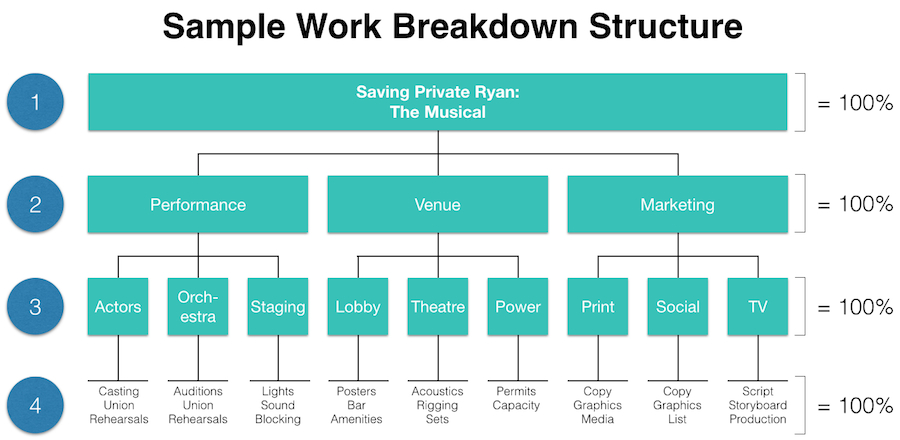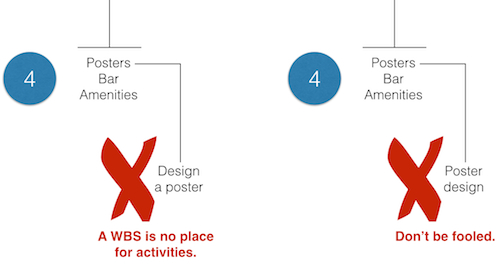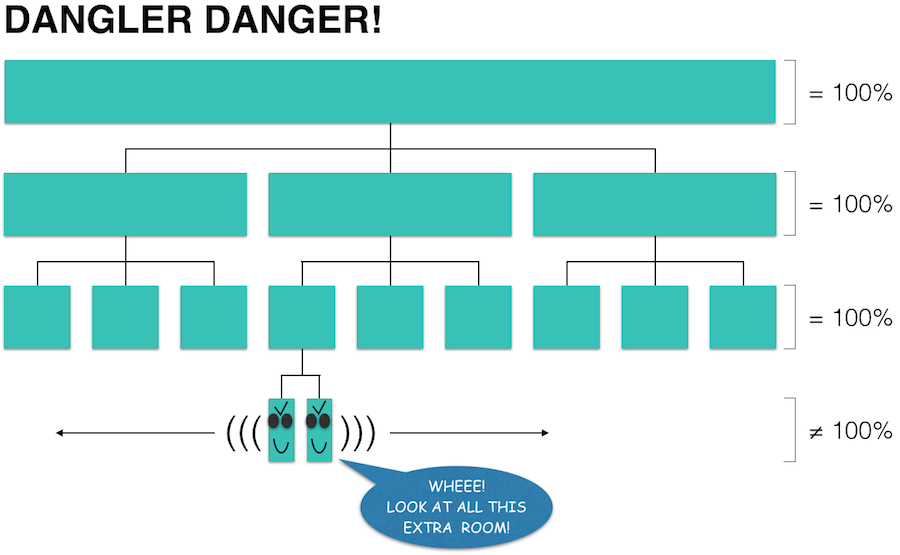
There seems to be a lot of confusion about a WBS and how to put one together. This is true in a classroom, but I’ve also seen a lot of Work Breakdown Structures that kind of missed the mark during my travels as a professional. A WBS is not difficult to make, but I think confusion over the document’s purpose might make the work seem harder than it really is.
So I thought I’d spend some time today and put together my take on this process.
ALRIGHT, HOW DO I MAKE ONE OF THESE STUPID THINGS?
At the highest level of a WBS, I’m going to try to capture the entire breadth of my project in one short name. Let’s say I’ve optioned the movie Saving Private Ryan with the intention of turning it into a smash musical with runaway hits like “The Bullets are Flying (And I Just Had My Hair Done)” and “Napalm Means You Can’t Take That Outfit Back”. I could represent 100% of this work with a simple box like so:

Let’s note a couple things about this box. First, I’ve put a number beside it. This represents the row of the WBS on which I can find this item (I could call it 0 as well, some people do that and it’s okay). Second, this box represents 100% of my project scope. Anything that falls beneath it must also be in scope. However, anything that sits adjacent to this box is not in scope and that’s important to know, too.
Finally, the words in this box represent a thing. It’s a noun–something I could (theoretically) reach out and touch. That will be important later.
There’s a problem with this box, though. I can’t really do anything with it – it’s just too broad. I need to take a look at what might be inside it and break it down a little bit. Perhaps, after some thought, I realize that there are three “buckets” of work that I’ll have to worry about to make my musical. Those things could be the performance itself, the venue and marketing the production. I can’t think of anything else right now, so I’ll create some new boxes on the next row to represent this work.

Notice something? All these items combined add up to 100% of project scope, just like on the previous row. Also, the boxes once again contain only the things I need to worry about: more nouns. There are no activities (or verbs) here.
Perhaps, when I look at each of these new boxes, I can break those contents down even further. For the performance, for example, maybe I need to worry about the actors and the orchestra, but also what goes on behind the scenes on stage. Those things aren’t related to the venue, though. Maybe where it comes to the venue I have to think about what happens in the lobby, the theatre, and maybe there will be substantial electrical work, too. I can similarly break marketing down into component pieces.

Once again, this new row represents 100% of project work and contains only nouns. In fact, when I sit down and really look at this new row, I can probably break my work down one more time. The result is a very clear representation of all the different scope elements across my entire project.

Gosh, doesn’t that look fancy? But it’s more than just pretty. The WBS is a very practical tool the helps you build up a project schedule.
EQUIVOCATION EVILS
 “Ugh, Geoff, I hate it when you use big words.” Okay, okay. The word “equivocation” essentially means “splitting hairs over what a word really means”. As you might have noticed above, I made a big fuss about ensuring I only put nouns in each node (block) of my WBS.
“Ugh, Geoff, I hate it when you use big words.” Okay, okay. The word “equivocation” essentially means “splitting hairs over what a word really means”. As you might have noticed above, I made a big fuss about ensuring I only put nouns in each node (block) of my WBS.
I did that because I specifically want to avoid using verbs. Verbs imply activities. And we already have a document where we put activities – that’s our project schedule. If I’m building a WBS, though, I’m not ready to think about that, yet. At this stage, all I’m trying to do is understand WHAT I need to get done. I’ll worry about HOW I plan to do the work later on.
Since it’s important to keep verbs out of the WBS, though, what a lot of people do is fuss around with their presentation. If, for example, I have a bucket of work called “Rigging”, there might be an associated task called “install cables”. Since I don’t want to have verbs in my WBS, I might be inclined to reword this to “cable installation”, sneakily avoiding the verb.
However, this is only going to hurt you. Equivocation here will create a document that is a Frankenstein hybrid of work packages and associated schedule information. That would be bad. If an element you want to add feels like an activity, it probably is an activity. Keep it out of here.
WHY, GEOFF? FOR PETE’S SAKE, WHY?
So, what IS the point of all this? Is the WBS just some obnoxious piece of make-work that the PMI came up with to force you to produce more paper?
No! The WBS is meant to the be the foundation of your entire project schedule! Here’s how it all works. Once you’ve completed your WBS, now you have a full deconstruction of all the scope on your entire project. That’s important! Once you know what you have to do, now you’re free to figure out how you need to do it.
Transfer the completed WBS into your scheduling software (like Microsoft Project), and voila! You have a complete skeleton for your entire project! Now, for each node of your WBS, you can easily insert the individual tasks you need to perform. Having gone through the hard stuff, you’re much less likely to miss anything than you would be if you didn’t carefully break down your project scope.

Do you see something? If I had allowed verbs to creep into my WBS, I would wind up with tasks as WBS headings, and STILL have to add tasks to my project schedule. This could make my schedule very confusing to read and maintain.
Also, the project schedule is the right place to put your tasks. That’s because a project schedule lets you visualize how tasks hang together. You can see graphically see dependencies, look at work overlaps, see groupings and durations in a way that the WBS just can’t let you see.
THE 100% RULE
Way up above I also made a fuss about each level of the WBS containing 100% of project scope. This is important for two reasons. First of all, using this approach I can see the entire breadth of my project no matter which level of the WBS I’m looking at. I can’t ever lose sight of how much I have to accomplish.
Second, if I decompose some work into a new level of the WBS but not others, I wind up with danglers. Just like with your nose, danglers are bad. In a WBS context, they will tend to fill any vacant space on their own, simply because there appears to be room for it.
If some WBS elements can be further deconstructed than others, it’s wise to just stop at the last level that gives you a complete view of your project. The easiest rule of thumb to follow? Stop when you hit your first verb.

Do you make Work Breakdown Structures on your project? Did you find this article helpful? I’m very interested in hearing others’ take on the WBS so please let me know your thoughts in the comments below!










